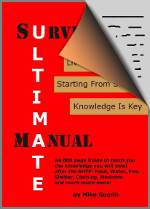Mushrooms Wild Edible Food
Mushrooms:OK, mushrooms aren't technically plants, but they resemble plants and we are talking survival not college!
The thing to keep in mind with mushrooms is that species identification is critical and many mushrooms will not only make you sick but many will kill you dead!!! Keep in mind that some mushrooms that are considered edible can cause allergic reactions in some, and old specimens can cause food poisoning. Also mushrooms growing in polluted locations or growing on treated wood can accumulate pollutants such as heavy metals and should be avoided.
With that said this shouldn't scare you away from all mushrooms. You don't need to even know how to identify the deadly ones. Simply learn a few of the good ones, learn to identify them and avoid all others.
Reason to keep mushrooms in mind is because they aren't plants and therefore don't get nutrients from the sun. This allows them to utilize places to grow and times that might have them available to you when no other or few other plants are available.
We will concentrate here on teaching you 6 species of edible mushroom which are known collectively as the "safe six"!
First of the six is morels! The morel mushroomavailability varies depending on your location but it arrives in the spring months for most locations. Before you can eat one you need to know what it looks like and what it looks like cut open. Morels have somewhat of a brain or sponge look or even described as looking sort of like male genitalia. But that isn't good enough to tell you that it is a morel because there is a mushroom known as false morels that are poisonous. To tell the difference simply take a knife and cut the mushroom in half from top to bottom. If the mushroom is good to eat it will be hollow. If it is a false morel and therefore poisonous the mushroom will be pretty much solid.
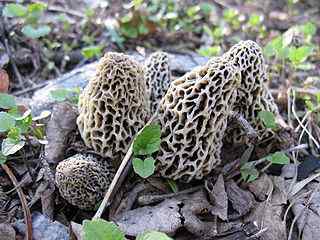
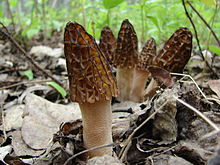 Remember, false morels will not be hollow. The centers will be either whole or filled with a cotton like substance. If the mushrooms are not hollow like a straw then discard them!
Remember, false morels will not be hollow. The centers will be either whole or filled with a cotton like substance. If the mushrooms are not hollow like a straw then discard them!
Morels can be dried for winter use. Hang them strung on string, with a knot between each mushroom to keep them from touching. Hang them in a dry place. Before using dried morels, soak in milk to restore freshness, or grind into mushroom powder.
The second edible mushroom we will introduce is the group called shaggy manes. The Shaggy Mane mushroom is a very common and readily identifiable mushroom. The first thing to look for in identifying a shaggy mane mushroom is the bullet-like shape of its top(cap). Secondly this cap will always be covered with very thin, fragile scales that will undoubtedly begin to flake off when handled.
The cap also melts into a black goo starting at the outer edge of the cap. Now this species starts out small and is edible then but NEVER eat a small one as there are poisonous species that look similar but do not get nearly as large. By avoiding shaggy mane mushrooms less than 4 inches tall you effectively are ruling out as a possibility you have collected the wrong species.
Also you need to look at the underside of the mushrooms cap and be sure that it has gill structure. The gills will be tightly packed so look closely. If gills are present you are good to go, if not discard the mushroom.
The gills beneath the cap start white, and then turn pink, then turn black and secrete a black liquid. They are best eaten before they turn black. The cap will begin to liquefy as it gets older and is still edible at this point but is not very tasty. Remember there are lookalikes that do not have the long tall stalks of the edible shaggy manes.
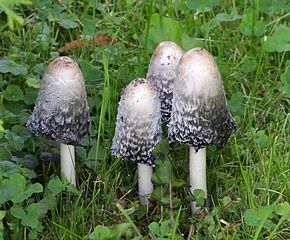
A British species called Magpie Fungus can be confused with shaggy manes so take it upon yourself to learn its identification or avoid eating shaggy manes in Britain.
The third mushroom we will look at is commonly known as "the hen of the woods". This mushroom does not have the classic stalked mushroom look and does not really look all that appetizing. But looks can be sooo deceiving! The hen of the woods grows in clusters at the base of trees.
The hen of the woods can be recognized by its brownish, wavy caps, which occur in large clusters of rosettes. Usually found on the base of oak trees, sometimes ones that are still alive but experiencing butt rot.
There are a couple of similar species that you could confuse with hen of the woods but both are edible, namely Polyporus umbellatus, very good eating and Meripilus sumstinei, also an edible mushroom.
The hen of the woods is awesome for a number of different reasons. A few are the taste and the sheer size, up to 40 pounds (18 kg), and its availability during the summer and fall.
Be wary that although this mushroom is not poisonous you don't want to eat it if the mushroom has taken on an orange color. This color indicates it is old and past its prime. The color comes from other harmful molds that are not good to eat and the flavor would be worse as well.
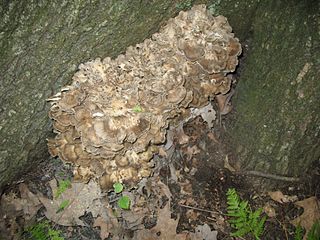
Number four is the chicken mushroom. This mushroom is easy to recognize and has no poisonous look-alikes is common and widespread. So if you only learn one this one is a great candidate. It has a long season, and it can be huge, providing more than just a passing nibble.
Chicken mushrooms are flat, fan-shaped, yellow to bright orange color with overlapping caps 2 inches to 12 inches (5-30 cm) across. They are most delicious when they are young. When it is too old to eat the mushroom will be dry and crumble.
The chicken mushroom gets its name from the fact that it tastes a lot like chicken. Enjoy!
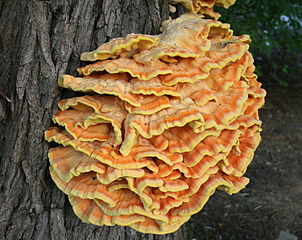
Number five of the safe six is the oyster mushroom. You will find oyster mushrooms on trees in the wild. This is a fall mushroom and isn't available during the spring and summer. The young, translucent, grow from the surface of dead trees, usually hardwood trees. The cap is scallop shaped.
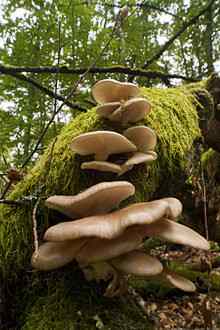 The oyster mushroom is a commonly cultivated mushroom, so you aren't just eating something because you're starving this is a mushroom that is actively grown and cultivated like any other food crop.
The oyster mushroom is a commonly cultivated mushroom, so you aren't just eating something because you're starving this is a mushroom that is actively grown and cultivated like any other food crop.
Identification tips:The gills run all the way onto the stem and aren't separate from the stem like in most mushrooms. Grow in overlapping clusters. Caps are smooth with no warts or scales, white, tan or light brown in color with firm, white flesh. Stem might not be present and will often be stubby and off-center when growing on the side of a log. If it's growing on the top the stem will be bigger and obvious. No ring around the stem. No sack around the base.
There are a number of lookalikes that you can be confused with an oyster mushroom by a novice. But fortunately the only poisonous look alike is Omphalotus nidiformisand it is only found in Japan and Australia so become familiar with it if you live in those countries.
The last of the safe six is the puffballs. Unlike the others here which are not a single species but a small group of mushrooms the puffball mushrooms entail MANY different species, families and genus. Puffballs are edible when the interior is white and firm. When they get older and the interior starts to turn color they will taste horrible.
Puffballs as the name implies look like... well, puffballs. Puffballs like most mushrooms can be confused with highly deadly mushrooms of other species. The puffball itself doesn't look like other poisonous mushrooms... at least not when the others are mature. You must be cautious of confusing immature poisonous mushrooms with puffball mushrooms. To tell the difference, cut the mushroom in half from top down and make absolutely sure there is no indication of a developing mushroom with cap, gills, and stem within the mushroom. If there is, you have the extremely poisonous mushroom and it should be discarded. Edible puffball mushrooms do not have these structures!
Also the Pigskin Poison Puffball is purplish on the inside and although it is unlikely to kill you it will likely make you sick to your stomach. Remember edible puffballs will be pure white inside and not purplish.
And don't let the name puffball confuse you, not all puffballs are small. Some, like the giant puffball can reach two foot in diameter.
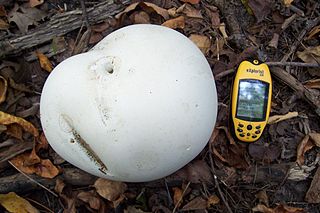
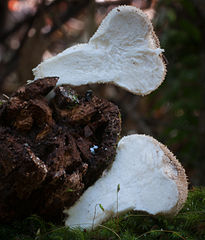
The thing to keep in mind with mushrooms is that species identification is critical and many mushrooms will not only make you sick but many will kill you dead!!! Keep in mind that some mushrooms that are considered edible can cause allergic reactions in some, and old specimens can cause food poisoning. Also mushrooms growing in polluted locations or growing on treated wood can accumulate pollutants such as heavy metals and should be avoided.
With that said this shouldn't scare you away from all mushrooms. You don't need to even know how to identify the deadly ones. Simply learn a few of the good ones, learn to identify them and avoid all others.
Reason to keep mushrooms in mind is because they aren't plants and therefore don't get nutrients from the sun. This allows them to utilize places to grow and times that might have them available to you when no other or few other plants are available.
We will concentrate here on teaching you 6 species of edible mushroom which are known collectively as the "safe six"!
First of the six is morels! The morel mushroomavailability varies depending on your location but it arrives in the spring months for most locations. Before you can eat one you need to know what it looks like and what it looks like cut open. Morels have somewhat of a brain or sponge look or even described as looking sort of like male genitalia. But that isn't good enough to tell you that it is a morel because there is a mushroom known as false morels that are poisonous. To tell the difference simply take a knife and cut the mushroom in half from top to bottom. If the mushroom is good to eat it will be hollow. If it is a false morel and therefore poisonous the mushroom will be pretty much solid.


Morels can be dried for winter use. Hang them strung on string, with a knot between each mushroom to keep them from touching. Hang them in a dry place. Before using dried morels, soak in milk to restore freshness, or grind into mushroom powder.
The second edible mushroom we will introduce is the group called shaggy manes. The Shaggy Mane mushroom is a very common and readily identifiable mushroom. The first thing to look for in identifying a shaggy mane mushroom is the bullet-like shape of its top(cap). Secondly this cap will always be covered with very thin, fragile scales that will undoubtedly begin to flake off when handled.
Also you need to look at the underside of the mushrooms cap and be sure that it has gill structure. The gills will be tightly packed so look closely. If gills are present you are good to go, if not discard the mushroom.
The gills beneath the cap start white, and then turn pink, then turn black and secrete a black liquid. They are best eaten before they turn black. The cap will begin to liquefy as it gets older and is still edible at this point but is not very tasty. Remember there are lookalikes that do not have the long tall stalks of the edible shaggy manes.

A British species called Magpie Fungus can be confused with shaggy manes so take it upon yourself to learn its identification or avoid eating shaggy manes in Britain.
The third mushroom we will look at is commonly known as "the hen of the woods". This mushroom does not have the classic stalked mushroom look and does not really look all that appetizing. But looks can be sooo deceiving! The hen of the woods grows in clusters at the base of trees.
The hen of the woods can be recognized by its brownish, wavy caps, which occur in large clusters of rosettes. Usually found on the base of oak trees, sometimes ones that are still alive but experiencing butt rot.
There are a couple of similar species that you could confuse with hen of the woods but both are edible, namely Polyporus umbellatus, very good eating and Meripilus sumstinei, also an edible mushroom.
The hen of the woods is awesome for a number of different reasons. A few are the taste and the sheer size, up to 40 pounds (18 kg), and its availability during the summer and fall.
Be wary that although this mushroom is not poisonous you don't want to eat it if the mushroom has taken on an orange color. This color indicates it is old and past its prime. The color comes from other harmful molds that are not good to eat and the flavor would be worse as well.

Number four is the chicken mushroom. This mushroom is easy to recognize and has no poisonous look-alikes is common and widespread. So if you only learn one this one is a great candidate. It has a long season, and it can be huge, providing more than just a passing nibble.
Chicken mushrooms are flat, fan-shaped, yellow to bright orange color with overlapping caps 2 inches to 12 inches (5-30 cm) across. They are most delicious when they are young. When it is too old to eat the mushroom will be dry and crumble.
The chicken mushroom gets its name from the fact that it tastes a lot like chicken. Enjoy!

Number five of the safe six is the oyster mushroom. You will find oyster mushrooms on trees in the wild. This is a fall mushroom and isn't available during the spring and summer. The young, translucent, grow from the surface of dead trees, usually hardwood trees. The cap is scallop shaped.
 The oyster mushroom is a commonly cultivated mushroom, so you aren't just eating something because you're starving this is a mushroom that is actively grown and cultivated like any other food crop.
The oyster mushroom is a commonly cultivated mushroom, so you aren't just eating something because you're starving this is a mushroom that is actively grown and cultivated like any other food crop.
Identification tips:The gills run all the way onto the stem and aren't separate from the stem like in most mushrooms. Grow in overlapping clusters. Caps are smooth with no warts or scales, white, tan or light brown in color with firm, white flesh. Stem might not be present and will often be stubby and off-center when growing on the side of a log. If it's growing on the top the stem will be bigger and obvious. No ring around the stem. No sack around the base.
There are a number of lookalikes that you can be confused with an oyster mushroom by a novice. But fortunately the only poisonous look alike is Omphalotus nidiformisand it is only found in Japan and Australia so become familiar with it if you live in those countries.
The last of the safe six is the puffballs. Unlike the others here which are not a single species but a small group of mushrooms the puffball mushrooms entail MANY different species, families and genus. Puffballs are edible when the interior is white and firm. When they get older and the interior starts to turn color they will taste horrible.
Puffballs as the name implies look like... well, puffballs. Puffballs like most mushrooms can be confused with highly deadly mushrooms of other species. The puffball itself doesn't look like other poisonous mushrooms... at least not when the others are mature. You must be cautious of confusing immature poisonous mushrooms with puffball mushrooms. To tell the difference, cut the mushroom in half from top down and make absolutely sure there is no indication of a developing mushroom with cap, gills, and stem within the mushroom. If there is, you have the extremely poisonous mushroom and it should be discarded. Edible puffball mushrooms do not have these structures!
Also the Pigskin Poison Puffball is purplish on the inside and although it is unlikely to kill you it will likely make you sick to your stomach. Remember edible puffballs will be pure white inside and not purplish.
And don't let the name puffball confuse you, not all puffballs are small. Some, like the giant puffball can reach two foot in diameter.



